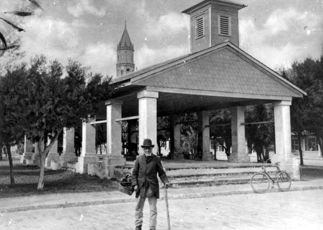
New research suggests that the photograph above is of Jack Smith, whose African name was Sitiki. If so, it is historically important in that “Uncle Jack,” as he was known in St. Augustine, was a formerly enslaved man, who stands in front of what many regard as the site of the former slave market. The white slaveowner, Buckingham Smith, left to Jack Smith a life interest in a parcel of land in the Lincolnville neighborhood of St. Augustine “for the use of the black people of St. Augustine and their successors in all time to come…providing first for the aged and invalid of those blacks which have been mine.” Until his death, Jack Smith lived in a cabin on the site. In accordance with Buckingham Smith’s wishes, the remainder of his estate became the Buckingham Smith Benevolent Association, a corporation with a mission to benefit the black people of St. Augustine and their successors for all time to come. The association continues to provide care for the elderly.
More information about Sitiki (Jack Smith) can be found in Odyssey of an African Slave (2015), an autobiography edited by Patricia C. Griffin, an independent historical anthropologist. Published by the University of Florida Press, it tells the story of Sitiki (Jack Smith), who was born in Africa, where he was captured as a five-year-old, and died Sept. 3, 1882 at 95 as a free man. Late in life, Smith became the first black Methodist minister in St. Augustine, Florida.
Jack Smith wrote his autobiography between 1869 and 1871 with the assistance of historian Buckingham Smith, his former master. In it, Smith describes places in St. Augustine that are recognizable, although his manuscript is almost 140 years old. Recently discovered as a hand-written document in the Buckingham Smith Collection at the New York Historical Society, it is thought to be the only first-person slave narrative to emerge from Florida. Sitiki’s story is also featured at the Lincolnville Museum and Cultural Center in St. Augustine, Florida.